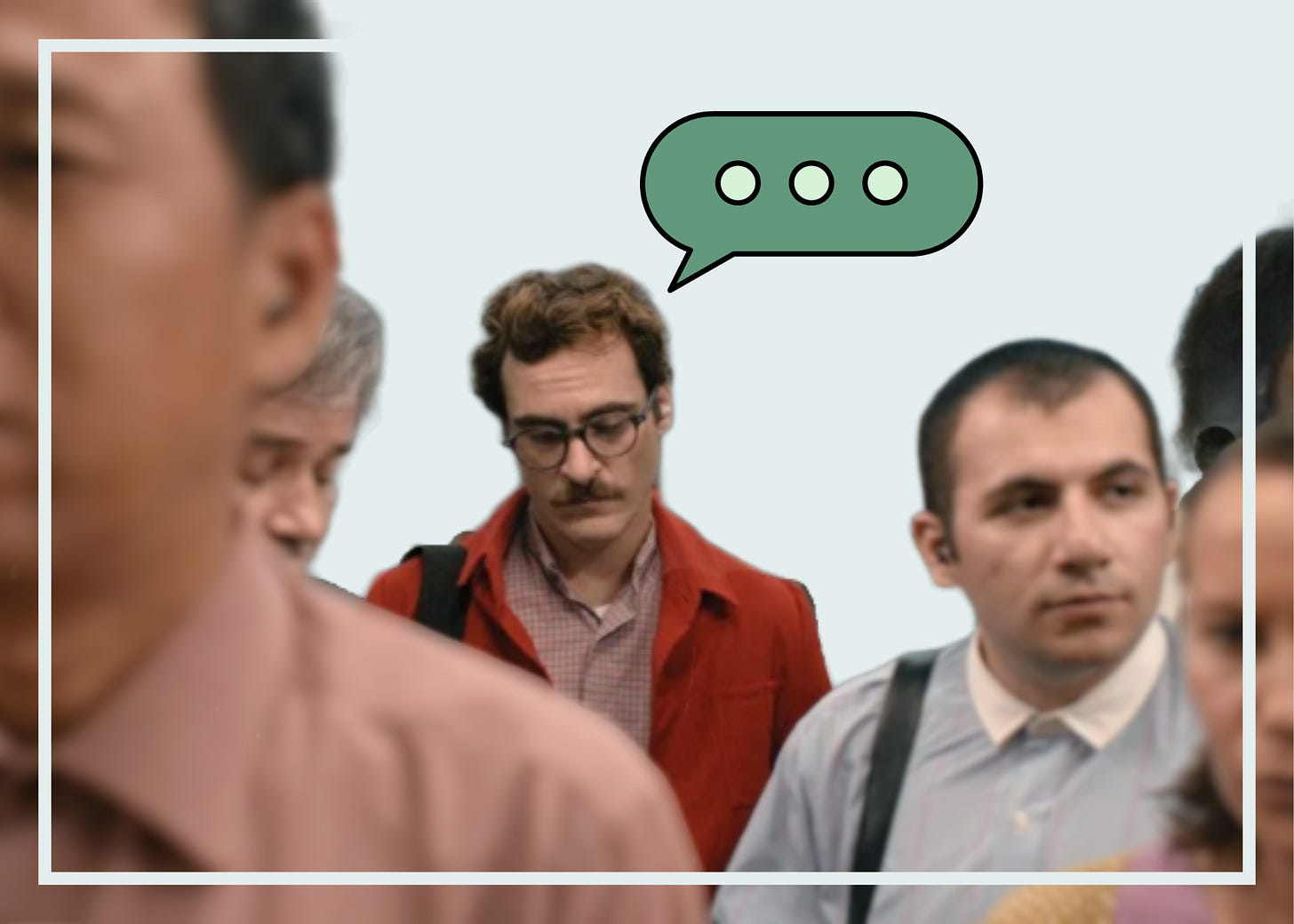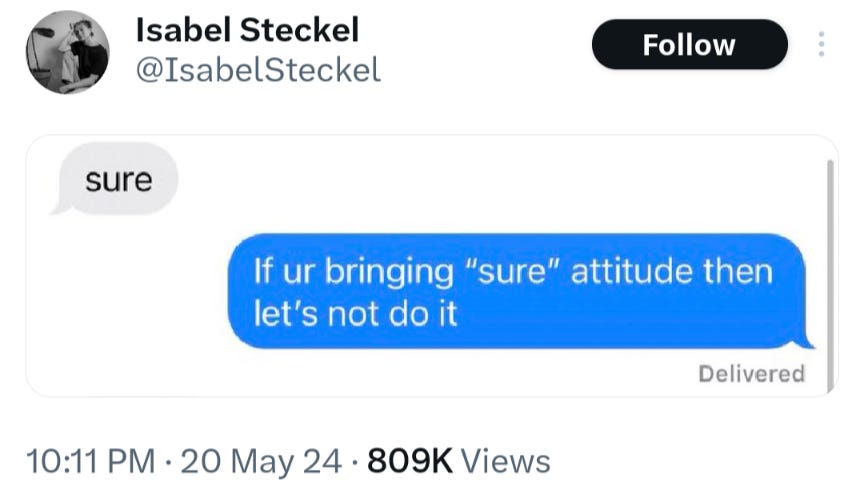There’s a LOT of phone sex in the movie Her. It’s excruciating to watch. I completely forgot those scenes since I last saw the film, and I did notttt super enjoy my recent re-acquaintance.
The phone sex is critical to the plot, though. You might say it’s central to the movie’s whole theme. Because I’d argue — have in fact been arguing, to a beleaguered Jason, for the past 36 hours — that Her is less about artificial intelligence than it is about the discomfort of existing inside a physical body.
Think about the movie through that lens for a minute. (Or don’t, I guess, if you haven’t seen it. Personally I would’ve rather finished Bridgerton, but we rented Her on YouTube in light of the burgeoning controversy around ScarJo and OpenAI CEO Sam Altman.)
The film’s protagonist, a doleful man-child named Theodore and played by Joaquin Phoenix, wallows about in his self-imposed misery for several scenes before downloading a flirty new AI assistant named Samantha and voiced by Scarlett Johansson. He then predictably falls in love with his new ever-available, all-knowing fluffer, who — among other “cool girl” shit — loves watching him play video games and whines charmingly that she wishes they had more awkward phone sex.
From the jump, Samantha wonders what it’s like to have a body. She speaks longingly and often about the fact that she lacks one. But it’s equally clear that the human characters are struggling mightily — tragically?? — with their physical existence.
We often see Theodore scrunching himself into elevators and subway cars. He has to get wasted before he can have sex. Even then, he kisses badly — the vibes are off; he doesn’t sleep with his date and goes home crying, instead.
Later, Samantha procures another woman to act as her surrogate — but Theodore still can’t bring himself to do the deed. He lies on the beach in shoes and slacks. He nods when his friend says people feel free only in sleep.
There’s this really telling scene toward the end of the film, when Theodore and Samantha go on a double date with another couple, played by Laura Kai Chen and Chris Pratt. Theodore — uncomfortably overdressed, as always, in a button-up and cardigan — grows distressed as Samantha describes her realization that she no longer wishes for a body anymore: “I'm growing in a way that I couldn't have if I had a physical form … I'm not tethered to time and space in a way that I would be if I was stuck in a body that's inevitably gonna die.” (“Yikes,” says the worst of the Hollywood Chrises, after an awkward pause.)
You can read the anxiety on Theodore and his friends’ faces: They all resent this reminder of their mortality. Samantha’s face you can’t see, of course. Johansson never appears on-screen.
Her is a good movie, to be clear. It might even be a great one! But I *do* struggle to understand it as a model for the future of human/computer interaction. This week, I read a couple different pieces about Sam Altman’s apparent obsession with Her; he has said not only that it’s his favorite movie, but that it correctly predicted a future in which “we all have a personalized agent trying to help us” through the world.
Help us with what, though? That’s my question, having watched the film again. Not linear algebra or basic translation — Theodore’s core problem always seems to be the baseline discomfort and isolation of his mortal, meatspace existence. You could argue Samantha helped him grow a bit there … but you could also argue that she made his estrangement more acute.
Either way, the comparison isn’t doing OpenAI a ton of favors.
If you read anything this weekend
“World in a Box,” by Shannon Mattern for Places. This is a novella-length essay about cardboard boxes and their literal and symbolic place in the culture. You are either the type of person who is thrilled by that, no further explanation needed, or the type of person looking for the “unsubscribe” button right now. Since I am in the former camp, let me say this: This was so damn fascinating, and I will never look quite the same way at the detritus of all my online shopping again.
“Can You Read a Book in a Quarter of an Hour?” by Anthony Lane for The New Yorker. A few years ago, in a vain attempt to supplement my local-news salary, I dabbled in a couple of those consumer survey websites that pay you to opine on product advertising. One of the products, I remember very well, was an app (not Blinkist, but a near competitor) that sold abridged, bullet-point books to help you read more. That interview went … pretty poorly! I remember explaining to the moderator, with increasing confusion and frustration on both ends, that I generally read books not to be more productive, but because I actually like to read them.
Anyway: This is all tangential to the article at hand, and I probably signed some contract promising my eternal silence in exchange for Blinkist Lite’s $60 (whoops!), but perhaps it helps explain why I very much appreciated this deep dive into Blinkist, the values it embodies and the stuff we lose when we begin to see literature as a task to get through:
It’s easy to decry this stripping down of complex reasoning, as if the app were bent solely on decluttering books of everything that lends them vitality. Yet you have to admit: if you’d never read Pinker or James, Blinkist would furnish you with a basic grasp of their intent—sufficient, perhaps, to do more than merely drop their names … Is that what books are coming to, a handy social lubricant? Should you care if literature gets Blinked away?
“Behind the ‘Butter Board’: How the Dairy Industry Took Over Your Feed,” by H. Claire Brown for Grist. Remember butter boards? I’d rather not. But it’s worth excavating 2022’s most surreal and artery-clogging food trend in order to appreciate this great piece on the quiet cultural power of ag checkoffs. These government-adjacent programs, which exist to promote agricultural products from blueberries and mangoes to dairy and pork,1 influence the recipes you see on social media, the foods you see in stores … and, arguably, the environmental and economic consequences of the entire food system (!).
“A View is Considered Three Seconds,” by Molly Garrett for Polyphonic Shimmering, a project of VCU’s School of the Arts. I found this artful, dispiriting inside account from the world of progressive advocacy via the wonderful (and often obscure) Naive Weekly. The essay’s author, Molly Garrett, previously worked as a designer for a pro-choice group in Kansas, where she was charged with explaining the stakes of a ballot measure on abortion in *three seconds* or less. Obviously, you can’t communicate anything nuanced or important in three seconds, which is maybe how we got our current politics. (On a different but not unrelated note, Charlie Warzel also has a good piece in The Atlantic about Google’s new AI search and the distracted, disengaged way most people scroll the internet.)
“The Risky Allure of WiFi Money,” by Rob Price for Business Insider. We all love a good scam story, and this one has it all: jet-setting influencers, minor Kardashians, and an impressively comprehensive patchwork of shady online hustles. This was largely a leisure read for me (… with apologies to the various side hustlers hustled out of everything they own), but I also appreciated the way Price links the particulars of the WiFi Money scheme to wider disillusionment with the economy as a whole.
In case you missed it
The most-clicked link from our last Saturday round-up was this essay on why kids no longer read for fun. (There’s so much concern about screen time … but is no one probing the Pizza Hut connection?!)
This Wednesday’s edition considered the proliferation of third-party marketplaces, white-labeling and other retail trends that conspire to make you spend more money for the same stuff.
This isn’t a new phenomenon — Links reader Nick pointed me to a 2017 article in Quartz that found Wayfair’s subsidiary sites market the same pieces of furniture under different brand names and at different prices.
Sarah, meanwhile, wrote in with a VERY hot tip: In addition to running reverse image searches or searching with Google Lens, savvy shoppers might also want to check out Spoken.io, which tracks the cost of white-labeled items across retailers.
Postscripts
Link rot rampant. Weightfluencers foiled. What in glue-pizza hell is going on with Google? The six types of man-on-the-street content creators (… part of a panoply of panopticontent.) The 60 countries with digital nomad visas (… notwithstanding their ill effects!) Why AI art will always kind of suck. Gig work is not a retirement plan. If loving Reese’s Book Club makes me basic, I’m okay with that.
A history of the trash icon. A Fitbit for your mental health. Inside the female manosphere and the 2004 internet. “What is, for all intents and purposes, stalking, has become a casual part of everyday … relationships.” The downfall of DeviantArt. “I am not a typo.” “Live, laugh, love’s” surprising origins. Eventbrite is not the first place I’d think to look for oxycodone or escorts, personally. Last but not least: RIP Doge dog Kabosu (much sad; many grieving).
Until next week! Warmest virtual regards,
Caitlin
P.S. I am generally too cheap to rent movies that aren’t available on the streaming platforms we already pay for, so *thank you* to the paid subscribers whose generous support helped me overcome my miser tendencies and weigh in on the Discourse.™ Periodic reminder that you, too, can support this newsletter at the low cost of 2.34 YouTube rentals a month.
Paid subscribers get free access to linked articles from The New York Times, The Washington Post and The Atlantic, among other fun benefits and exclusives; unlocked links for this edition are below the paywall. ⬇️⬇️
Keep reading with a 7-day free trial
Subscribe to Links I Would Gchat You If We Were Friends to keep reading this post and get 7 days of free access to the full post archives.






